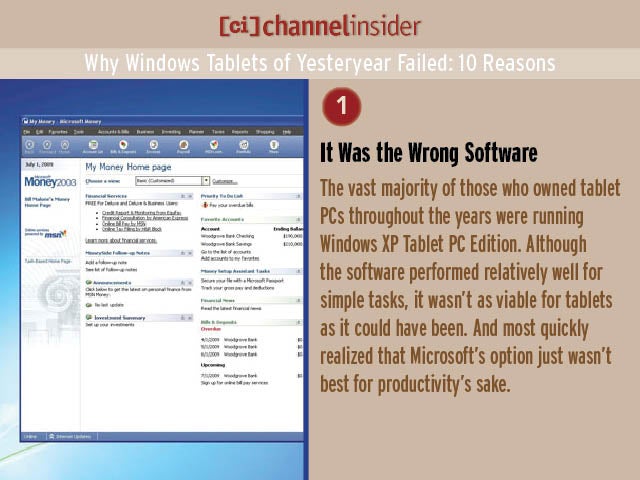 Why Windows Tablets of Yesteryear Failed 10 Reasons
Why Windows Tablets of Yesteryear Failed 10 Reasons
1. It Was the Wrong SoftwareThe vast majority of those who owned tablet PCs throughout the years were running Windows XP Tablet PC Edition. Although the software performed relatively well for simple tasks, it wasn’t as viable for tablets as it could have been. And most quickly realized that Microsoft’s option just wasn’t best for productivity’s sake.
 No Title
No Title
2. No Third-Party AppsThe iPad is successful today because of third-party applications. Owners can search Apple’s App Store, find programs they might want to use, and download them to the device. Tablet PCs lacked that functionality. And although they featured a full version of Windows, it simply wasn’t enough. When it comes to tablet computing, having simple third-party apps available is a must.
 No Title
No Title
3. Ubiquity of 3GAlthough 3G connectivity is available on tablets today, it wasn’t so readily available years ago. And so when enterprise customers had their tablets in tow, they weren’t typically able to access the Internet via 3G. Instead, they had to do so with Wi-Fi. It was a glaring omission, and it’s one that meant the difference between success and failure in the marketplace.
 No Title
No Title
4. It Relied Upon the StylusThe stylus was a key component in the functionality of the average tablet PC. The only issue was, Windows isn’t ideally designed for the stylus. And in many cases, the experience fell short for customers. The stylus was fine on mobile devices from companies like Palm, but for a full-fledged computer, it didn’t work so well.
 No Title
No Title
5. They Were Too BulkyPart of the value of a tablet PC is its that users can throw it in a bag and bring it along on trips. The only problem is, the vast majority of tablet PCs released throughout the years were bulky and heavy. The result was a general lack of mobility that made the devices all the more useless to the average consumer or enterprise customer.
 No Title
No Title
6. The Price Was Too HighTablet PCs were meant to be premium products that delivered something fresh to customers. But because of that “premium” focus, the devices tended to price themselves out of the market. Current slates, on the other hand, are more readily affordable. And that has helped them, led by Apple’s iPad, to increase adoption.
 No Title
No Title
7. Writing RecognitionOne of the key aspects of tablet PCs was the ability to write on the device with the stylus. The only issue is, writing recognition didn’t work all that well, and it tended to be more annoying than useful. That became a major issue for tablet PCs, and it’s precisely why usability is still a major concern for products available today.
 No Title
No Title
8. Vendors Weren’t SureThe real issue with tablet PCs has always been that major vendors, including HP, Lenovo, and others, didn’t quite know how much effort they should put into the tablets. They knew that the devices wouldn’t sell all that well, so they focused more of their efforts elsewhere. By doing so, vendors hurt their own products, in spite of their desire to make them more appealing. And they’re continuing to do that today.
 No Title
No Title
9. Consumers Saw No ValueConsumers have always looked at tablet PCs as products that they don’t really need. After all, they don’t provide the mobility of a smartphone nor the productivity opportunities of a notebook. They’re a middle-of-the-road product that in no way captures what customers are trying to achieve. That’s a major issue. And it’s one that current tablet PCs still aren’t solving.
 No Title
No Title
10. Notebooks Were All the Rage When tablet PCs became a little more popular over the years, they were competing against the rapid adoption of notebooks in the enterprise. For quite a while, desktops were all the rage in the enterprise. But companies needed employees to be more mobile, and notebooks satisfied that desire. At the same time, tablets were trying to gain traction. It didn’t work. And they quickly became the products only certain people at certain companies were using.

